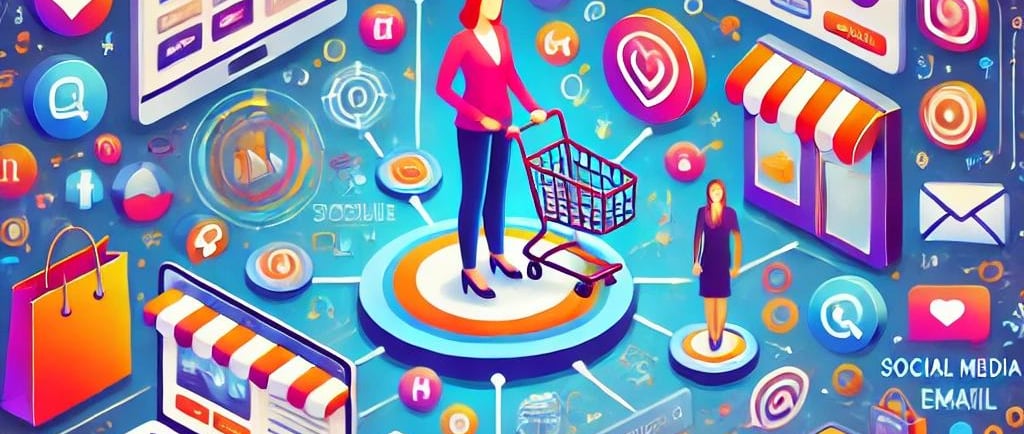The Power of Omnichannel Marketing: A Unified Customer Experience
In today’s fast-paced, digitally-driven world, consumers interact with brands through a variety of channels—social media, email, physical stores, websites, apps, and more. Omnichannel marketing is the strategy that unifies these touchpoints to create a seamless and consistent customer experience, regardless of how or where they engage with your brand.
Hessam Mahmoodi
1/31/20252 min read


What Is Omnichannel Marketing?
Omnichannel marketing ensures that all channels—whether online or offline—are interconnected, delivering cohesive messaging and a personalized experience for the customer. Unlike multichannel marketing, which uses multiple platforms independently, omnichannel focuses on integrating these platforms so they work together in harmony.
For example, a customer might see an ad on Instagram, click through to a website, add a product to their cart, and receive an email reminder to complete the purchase. If they visit a physical store, the retailer’s system could recognize their cart items and offer assistance in-store, creating a fluid experience.
Benefits of Omnichannel Marketing
1. Enhanced Customer Experience
Omnichannel marketing puts the customer at the center of the strategy. By delivering consistent messaging and personalization across platforms, customers feel valued and understood, fostering loyalty.
2. Increased Engagement and Retention
When customers can interact with your brand seamlessly, they’re more likely to stay engaged. A tailored experience—like product recommendations or personalized offers—keeps them coming back.
3. Higher Sales and Conversions
Omnichannel strategies meet customers where they are, making it easier for them to buy. Studies show that omnichannel customers spend more and are more likely to complete purchases than single-channel customers.
4. Improved Data Insights
By connecting all channels, brands can track customer behavior across their journey. This data offers invaluable insights to refine marketing strategies, personalize experiences, and predict future trends.
Key Elements of Omnichannel Marketing
1. Consistent Branding
Every channel—whether it’s your website, email campaign, or physical store—should reflect a cohesive brand voice, look, and feel.
2. Personalization
Use customer data to create tailored messages, product recommendations, and offers. Personalization is key to making customers feel seen and valued.
3. Cross-Channel Integration
Ensure your platforms share information. For example, if a customer abandons their cart online, your email system should trigger a reminder or special discount offer.
4. Mobile Optimization
With mobile devices playing a central role in shopping and communication, ensuring a mobile-friendly experience is non-negotiable.
5. Customer-Centric Approach
Put yourself in your customer’s shoes and focus on creating a journey that is intuitive and enjoyable across all channels.
Real-World Examples of Omnichannel Marketing
• Starbucks: The Starbucks Rewards app is a prime example of omnichannel marketing. Customers can order online, pay in-store with their app, and collect rewards seamlessly across platforms.
• Nike: Nike combines its app, website, and physical stores to deliver personalized experiences. Customers can reserve products online and pick them up in-store or get tailored product recommendations based on their preferences.
• Amazon: Amazon’s ecosystem ensures a seamless experience across its website, app, Alexa devices, and customer service, keeping customers deeply engaged with the brand.
How to Implement Omnichannel Marketing
1. Understand Your Audience
Dive into customer data to identify behaviors, preferences, and pain points.
2. Map the Customer Journey
Identify all touchpoints and ensure they’re connected, offering a smooth transition between platforms.
3. Invest in Technology
Use tools like customer relationship management (CRM) systems, marketing automation software, and analytics platforms to unify and analyze your channels.
4. Test and Optimize
Regularly review your omnichannel strategy’s performance, making adjustments based on customer feedback and data insights.
The Future of Omnichannel Marketing
As technology evolves, omnichannel marketing will become even more sophisticated, integrating innovations like artificial intelligence, augmented reality, and the Internet of Things (IoT). Brands that embrace this approach now will be better equipped to meet the demands of tomorrow’s consumers.
By adopting omnichannel marketing, your brand can deliver the unified, personalized experiences that today’s customers expect—building trust, loyalty, and long-term success.
Socials
Follow our socials for updates!
CONTACT
Connect
© 2025. All rights reserved @ MLT Marketerra Marketing Solutions.
